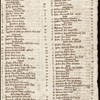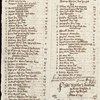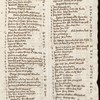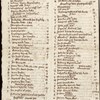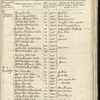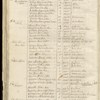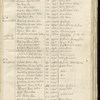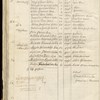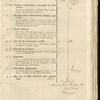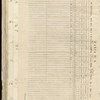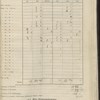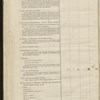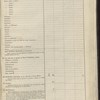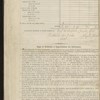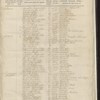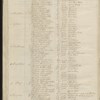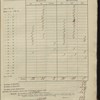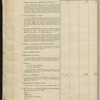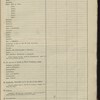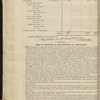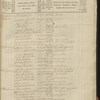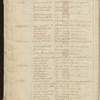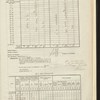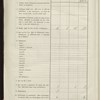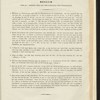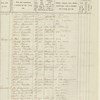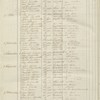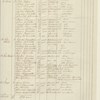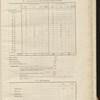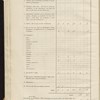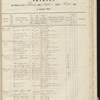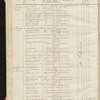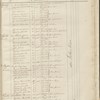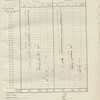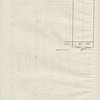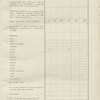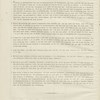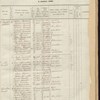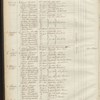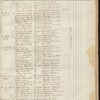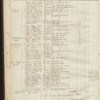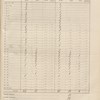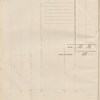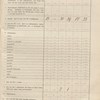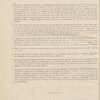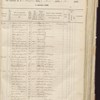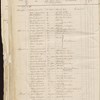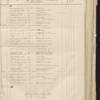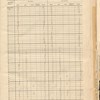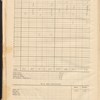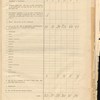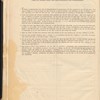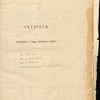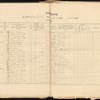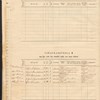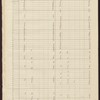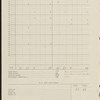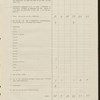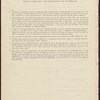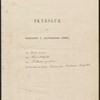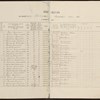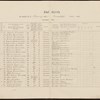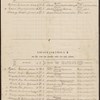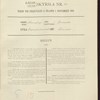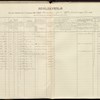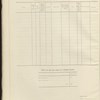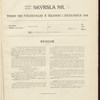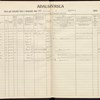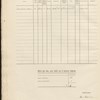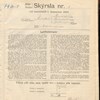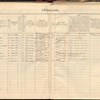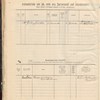On specific censuses
1703
-
1703 Census
The decision to carry out a national census in 1703 came about because of the poor economic situation in Iceland in the seventeenth century coupled with the run of cold winters at the end of the century that led to miserable living conditions for the nation's population. Árni Magnússon, Professor, and Páll Vídalín, Assistant Attorney, were therefore chosen to study the country's economy. In May 1702 they received instructions to carry out a national census. In October they sent detailed instructions to the county sheriffs throughout the country with the recommendation that all families and members of all households and each community should be counted. All indigent persons should be registered specially and vagrants were to be registered on the Saturday before Easter so that they would not be counted more than once.
The county sheriffs entrusted the district administrative officers with the job of carrying out the census taking. The census information was then turned in to Magnússon and Vídalín at the June 1703 session of the Parliament before being sent on to Copenhagen, as Iceland was at the time still a part of the Danish state. The census reports were returned to Iceland in 1921 and, in accordance with the agreement between Denmark and Iceland of 1927, then became the property of Iceland. The census was published by the Bureau of Statistics (now Statistics Iceland) in 1924-1947.
The census of 1703 is preserved in full. It was the first national census that counted all inhabitants throughout the country and gives name, age and social position of every inhabitant. Statistics Iceland had the printed version of the 1703 census scanned, with changes to the text. Statistics Iceland then presented this record to the National Archives of Iceland, which gratefully accepted it. The National Archives have made various improvements to the text. However, it should also be noted that there are plans to further improve the web version of the census.
Samples of the orginal census
1816
-
1816 Census
On 23 March 1815, Bishop Geir Vídalín wrote a letter to all regional deans in Iceland. As representative of the Bishop, a dean was responsible for a number of benefices, each with at least one parish. The letter accompanied a directive from the Chancellery in Copenhagen dated 11 December 1812, containing regulations pertaining to entries in church registers, and their format. Bishop Vídalín instructed the deans to obtain books that complied with the directive. Church registers should be folio (single-fold), and entries were to be made in two books at the same time. One book was to be for the whole benefice and kept in the custody of the pastor, and the other should be in a church in each parish or kept by the parish treasurer (deacon’s book/djáknabók). A census of parishioners made on the first Sunday in Advent, 1816 was to be entered at the front of that book. The census was to include information about name, position in society, age and birthplace, which was a new requirement.
Most pastors complied with the bishop’s request, but others ignored it. And despite the bishop’s instructions about the date, some pastors recorded the census in 1816, a few in 1817 and several later. So execution of the census did not quite go according to the bishop’s plan. Over time some of the parish registers have been lost for various reasons.
In the 1940s, the Icelandic Genealogy Society, Ættfræðifélagið, became interested in publishing this census collection because, among other things, it included information about birthplace which the Society deemed important. Marta Valgerður Jónsdóttir (1889–1969) had already made copies of the censuses that had been preserved and had reconstructed others, using available sources, in place of the ones that had been lost. Other genealogists contributed to the transcription and reconstruction of the censuses. This collection was printed in six parts in 1947–74 as Manntalið 1816 (1816 Census). In the final two parts, no attempt was made to reconstruct missing censuses; instead the regular household examination records were included, where available. In order to fill as many gaps as possible, it was necessary, for instance, to go back as far as 1802 to find household examination records for Sauðanes, and forwards to 1829 for Knappstaðir parish. A few parishes are missing because their household examination records were unavailable (Vatnsfjörður and Kirkjuból in the county of Ísafjörður, and Flugumýri and Fell in Skagafjörður). Nevertheless, over three-quarters of the Genealogical Society of Iceland’s 1816 Census derives from data relating to 1816, and over 96% from the period 1815–1820, so referring to the collection as the 1816 Census is regarded as acceptably accurate.
This online publication of the 1816 Census is based on the printed version. Under the heading Notes are, where appropriate, the corrections and additions from Part 6 of the printed version, in addition to footnotes and postscripts derived from the printed publication. Other informative comments are included. Each comment is preceded by a number in square brackets [n] indicating the source of each comment as shown in the following table:
1. Corrections and additions, p. 1065 in the printed version.
2. Corrections by Eyjólfur Jónsson of Flateyri, pp. 1065–67 in the printed version.
3. Corrections made by ex-teacher Þórarinn Einarsson to Barðaströnd county censuses, pp. 1067–69 in the printed version.
4. Footnotes in the printed version.
5. Endnotes in the printed version.
7. Other comments in the printed version.
8. Handwritten corrections/comments in the National Archives copy of the printed version.
9. Comments from transcribers: most relate to publication of data in the online census.
10. Additions by Marta Valgerður Jónsdóttir.
More detailed information regarding the 1816 census is available (in Icelandic) in Guðni Jónsson’s foreword to Part 1 of the census, pp. I–III, and Bjarni Vilhjálmsson’s afterword to Part 6, pp. 1071–76. These sources were consulted in preparation of this text.
1835
-
1835 Census
A national census was carried out in Iceland in 1835 parallel with the census in Denmark in February 1834. On 3rd of June 1834 the bishops of Iceland, the governor (stiftamtmadur) and the deputy governors (amtmenn) were sent a request (reskript) for a general census of the population of Iceland as a part of obtaining information about the number of people and the division of employment in the Danish colonies. It was the duty of the bishop and the governor to work together to carry out the census here in Iceland. The country-wide census was preferably to be completed on the same day, the actual day to be chosen as best suited to the authorities. Accordingly, the 2nd of February 1835 was chosen. The parish clergy, with the assistance of the district administrators or other appointed people, were to see to carrying out the census and processing the information acquired. The district administrators signed the census list and the parish clergy received the tables containing the information obtained. Some clergy confirmed that the tables had been drawn up by comparing them to the register of the relevant church congregation. There are examples of the clergy confirming that the census lists were in accordance with the register of the church congregation. The census data were preserved in Denmark. Then in 1904 the census was given to the Provencial Archives of Iceland (Landsskjalasafn Íslands), as the National Archives of Iceland was then called, for continued preservation.
The census of 1835 has been preserved in its entirety. A copy of the original reports was typed for use in the National Archives reading room in the 1960s. It has not been printed. The web version is a copy of the typed version.
Samples of the orginal census
1840
-
1840 Census
In 1840 the Danish state conducted a census that also extended to its colonies in the northern seas. Implementation of the count in Iceland was in the hands of the political authorities, the bishop and the governor (stiftamtmaður). The census took place on the 2nd of November. The bulk of the counting was carried out by the parish clergy and their assistants and people were counted on the basis of belonging to a parish. On completion of the count the parish clergy, the county sheriffs and the deputy governors (amtmenn) worked to compile the information from the count data into special tables that had been enclosed with the instructions for carrying out the census. The census documents were then sent to the Census Commission in Copenhagen (Tabelkomission in Kaupmannahöfn), the office within the department of finance (rentukammer), which had responsibility for the preparation of economic reports for the Danish state. In 1904 the census was handed over to the Provencial Archives of Iceland (Landsskjalasafn Íslands), as the National Archives was called at the time, for continued preservation.
The 1840 census has been preserved in its entirety. A copy of the original reports was typed for use in the National Archives reading room in the 1960s. It has not been printed. The web version is a copy of the typed version.
Samples of the orginal census
1845
-
1845 Census
A census of the Danish state and its colonies in the northern seas took place in 1845. As before, the direction of the census in Iceland was in the hands of the authorities, though the parish clergy and their assistants bore the brunt of the work of registering the populace in each parish. Instructions called for accomplishing the count on November 2nd, but because of conditions in Iceland the census takers were given several months to complete the project. After the census taking was completed the parish clergy, the county sheriffs and the deputy governors recorded the information from the census documents onto special forms that had been included with the instruction from the Danish authorities. Upon completion the documents were sent to the Census Commission at the department of finance (rentukammer) in Copenhagen, where they were preserved during subsequent decades. The 1845 census was then sent to Iceland in 1904 for preservation in the Provencial Archives of Iceland (Landsskjalasafn Íslands), as the National Archives was then called, for continued preservation.
The census of 1845 has been preserved in its entirety. A copy of the original reports was typed for use in the National Archives reading room in the 1960s. The web version is based on this typed version. In 1982-1985 the Genealogical Association published the census in book form supported by a grant from the Independence Fund and the state government.
Samples of the orginal census
1850
-
1850 Census
The census of Iceland in 1850 was the first that took place after the changes in the system of government in Denmark in the wake of the abolition of absolutism of the monarchy in 1848. The changes led to implementation of the census based on the earlier censuses. Each provost became responsible for the census documents on behalf of the new Icelandic government department in Copenhagen and directed the census taking with the aid of parish clergy in his district. The instructions to the clerks counted on carrying out the census during the summer. The actual day of the census was the 1st of February. On completion of the census the parish clergy processed the information from the census documents in special tables, as before. The provosts then collected the documents from the parish clergy, reviewed them and sent them on to Denmark. The 1850 census was then preserved in the Statistical Bureau, the forerunner of the Danish Bureau of Economics, until 1904, when it was turned over to the Provencial Archives of Iceland (Landsskjalasafn Íslands), as the National Archives was then called, for preservation. The documents have been in the National Archives of Iceland ever since.
The 1850 census is preserved in its entirety. A copy of the original reports was typed for use in the National Archives reading room in the 1960s. The web version is based on the typed version.
Samples of the orginal census
1855
-
1855 Census
The census of Iceland in 1855 was intended to be based on the population of the country on October 1st of that year. Conducting the census in Iceland was, as earlier, a part of census taking in the Danish state. The provosts were to be responsible for the census documents on behalf of the Icelandic government department in Copenhagen and directed the parish clergy who, together with their assistants, bore the brunt of the census taking. On completion of the work, the parish clergy entered the information from the census documents into special tables that the Danish authorities had enclosed with the instructions for the census. The provosts collected all of the census documents from the parish clergy for review and then sent them on to Copenhagen. The 1855 census was then in the custody of the Statistical Bureau, the forerunner of the Danish Bureau of Economics, during subsequent decades. In 1904 the 1855 census was turned over to the Provencial Archives of Iceland (Landsskjalasafn Íslands), as the National Archives of Iceland was then called, for continued preservation.
The 1855 census is preserved in its entirety. It appears here as in the original census reports.
Samples of the orginal census
1860
-
1860 Census
The census in Iceland was carried out in October 1860 and the count based on the 1st of that month. The count was a part of the census taking that was implemented in the Danish state that year. The provosts had responsibility for the counting in their own districts on behalf of the Danish government and entrusted the actual counting to the supervision of the clergy in each parish. The clergy then assembled a team of assistants who saw to the registration of the inhabitants of each parish. On completion of the count the clergy entered specific information from the census documents in tables that had been sent with the instructions on carrying out the census. The provosts then collected all the census data from their districts, reviewed it, and then sent it out to the Icelandic department of the government in Copenhagen. The census was then preserved at the Statistical Bureau, the forerunner of the Danish Bureau of Economics, during subsequent decades. In 1904 the census was turned over to the Provencial Archives of Iceland (Landsskjalasafn Íslands), as the National Archives of Iceland was then called, for continued preservation.
The 1860 census has been preserved in its entirety. A copy of the original reports was typed for use in the National Archives reading room in the 1960s. It has not been printed. The web version is based on the typed version.
Samples of the orginal census
1870
-
1870 Census
The census in Iceland in 1870 took place in October and was intended to be based on the population of the country on the 1st of October of that year. A change had taken place in the frequency of census taking in the state of Denmark as the census was now carried out at ten year intervals instead of five, as had been the case earlier. As before, the provosts bore the responsibility on behalf of the Danish government for census taking in their own districts and entrusted the actual counting to the parish clergy in each parish. The clergy them assembled a team of assistants who saw to the census taking. On completion of the count the clergy entered specific information from the census documents in tables that had been sent with the instructions on carrying out the census. The provosts then collected all the census data from their districts and reviewed it, after which it was sent to the government in Copenhagen for preservation. The 1870 census was archived by the Statistical Bureau, the forerunner of the Danish Bureau of Economics, during subsequent decades. In 1904 the census was turned over to the Provencial Archives of Iceland (Landsskjalasafn Íslands), as the National Archives of Iceland was then called, for continued preservation.
This census has not been preserved in its entirety as the census reports from the counties of Eyjafjardar, Thingeyjar and Múla were lost in Copenhagen. A copy of the original reports was typed for use in the National Archives reading room in the 1960s. It has not been printed. The web version is a copy of the typed version.
Samples of the orginal census
1880
-
1880 Census
This census was conducted in Iceland in 1880. Like previous censuses, its population figures are as of 1 October that year. By this time, the office of Governor General (Icel. Landshöfðingi) had been established in Iceland, following the adoption of the Status Act of 1871, and provosts were given their instructions on conducting the census by the Governor General. Deans continued to be responsible for submission of the census sheets for their districts and entrusted the parish clergy to supervise census-taking in their parishes. The clergymen recruited assistants to do the actual data-gathering. Once this was complete, the clergymen would then enter the information from the census sheets into tables which were included with their instructions for the census. The deans, in turn, received all the data for their district, which they were to review before sending it to the Governor General, who forwarded it to the Danish authorities. The 1880 census was subsequently kept by the Danish Statistical Bureau until it was delivered in its entirety to the Provincial Archives of Iceland (Landsskjalasafn), the forerunner of the current National Archives, in 1904. It has been preserved in the Icelandic archives since that time.
As was the case with many other censuses, a typed copy of the original 1880 census reports was made in 1960-1980, for use in the reading room of the National Archives. It was never printed. The web version is based on the typewritten version of the census.
Samples of the orginal census
1890
-
1890 Census
The census of Iceland in 1890 took place on the 1st of November. As in 1880, the governor general of Iceland [now designated landshöfdingi] entrusted the provosts with the responsibility of carrying out the census as had been done ten years earlier. Thus the people were counted by the parish they were in and the parish clergy assembled a team of assistants to see to the counting. The clergy then entered the information from the census reports obtained from their assistants and entered it in the tables that had been enclosed with the instructions from the governor. The parish clergy sent the census data to the provosts on completion of the processing of the data, who, after reviewing the data, sent the information on to the governor. From there the census information was sent to the Danish authorities for further processing. The 1890 census was then stored for several years within the walls of the Statistical Bureau, the forerunner of the Danish Bureau of Economics, until it was turned over in large part in 1904 to the Provencial Archives of Iceland (Landsskjalasafn Íslands), as the National Archives of Iceland was then called, together with earlier censuses. The delivery of the census was completed the following year when the Archives received the census reports from South Múla County. The census data have since been preserved in the National Archives.
The 1890 census has been preserved in its entirety. A copy of the original reports was typed for use in the National Archives reading room in the 1960s. It has not been printed. The web version based on the typed version.
Samples of the orginal census
1901
-
1901 Census
The census of Iceland was carried out in 1901 and the count based on the 1st of November, as had been done eleven years earlier. The governor ordered that the census be taken and assigned the responsibility to the provosts and parish clergy. The parish clergy assembled a team of assistants to see to the counting. The count was carried out in the parishes and in four towns, Reykjavík, Ísafjord, Akureyri and Seydisfjord. The mayor of each town performed the role of parish clergy in taking the census. On completion of the count it was then the responsibility of the parish clergy to process the information obtained from the census reports on the parish inhabitants in accordance with the instructions on taking the census. The town mayors were not intended to process the town data but instead to turn over the data to the governor. The provosts were then responsible for turning in to the governor all the census data from the clergy in their districts. The census of 1901 has been preserved by the National Archives of Iceland since the Danish government presented it to the Archives in 1928.
The census of 1901 has been preserved in its entirety. It appears here mostly following the original census reports. It has not been published.
Samples of the orginal census
1910
-
1910 Census
The census of 1910 of Iceland was the first that was not carried out under the supervision of the Danish government. The idea had been put forward a year earlier with the proposal of a resolution in the Icelandic Parliament that a census should be carried out and the government offices should be given the responsibility for doing so. The previous census methods were referred to, in the parishes and also in several towns, as had been done nine years before. However, this time the census was to be based on the 1st of December rather than the 1st of November, as before. The parish clergy were to be responsible for the census taking and assembled a team of assistants. The town mayors, on the other hand, saw to census taking in the towns and also made use of a team of assistants. The provost then saw to turning in the census data from the parish clergy to the ministry offices while the town mayors themselves sent in the data. After the ministry officials had completed their work on the census it was turned over to the National Archives of Iceland for preservation, where it remains.
The census of 1910 has been preserved in its entirety. It is recorded here as it appeared on the original census reports. In 1994-2003 the Genealogy Society published part of the census in book form in collaboration with the National Archives of Iceland and the Genealogy Committee.
Samples of the orginal census
1920
-
1920 Census
An Icelandic Census Act was adopted by the Althingi in February 1920, and received royal assent on 18 May that same year. The director of the Statistical Bureau drafted the bill of legislation.
The legislation assumed that the census would be taken on a single day, which would require a large number of census takers. A statutory provision made it compulsory for persons to serve as census takers if requested, in order that the most capable ones could not decline.
The Act provided for a general census to be taken of the entire country in every year ending in a zero. It was to take place on 1 December or another day as decreed by the king. The Statistical Bureau of Iceland was to prepare the model for forms for census sheets. On these forms the full name of each person was to be entered, together with his/her date of birth, place of birth, position and anything else that the Statistical Bureau should decide in each instance, in consultation with a committee elected for the purpose.
The Act listed only those details which it appeared obvious were to be asked in any census. The reasons for other questions could vary.
The 1920 census is preserved in its entirety, but has never been printed. This web version was prepared from the original census sheets.
Samples of the orginal census
